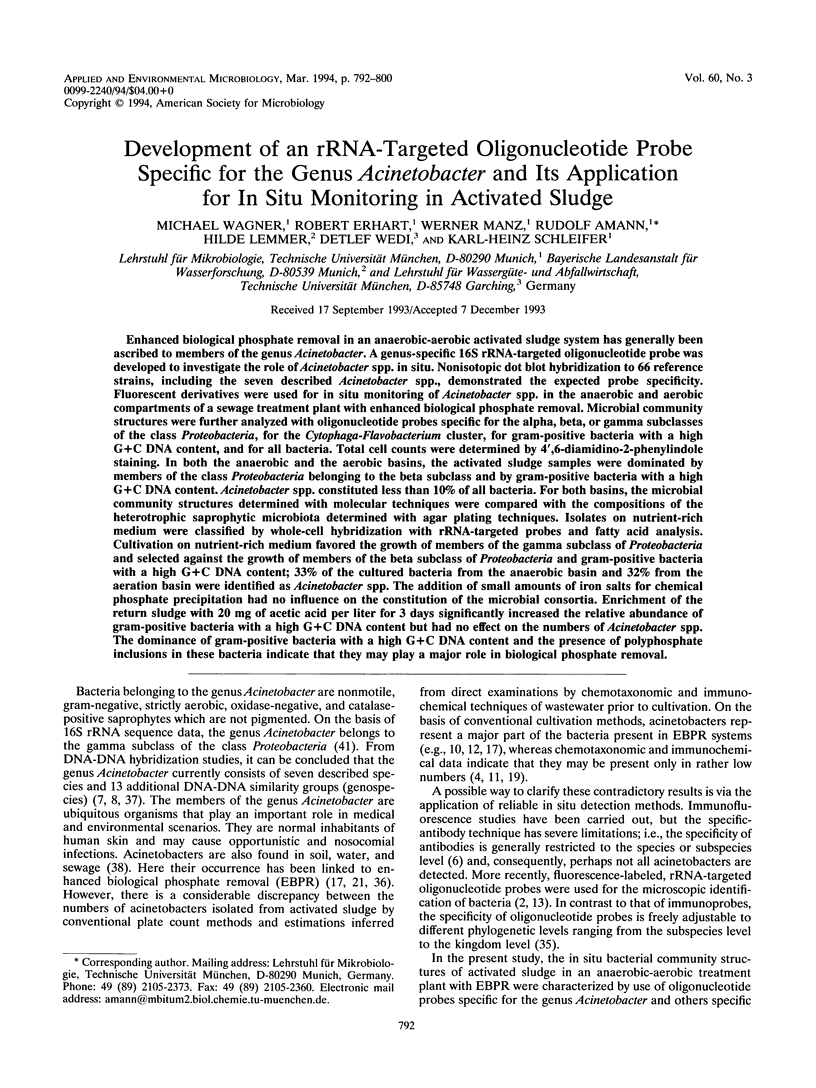Development of an rRNA-targeted oligonucleotide probe specific for the genus Acinetobacter and its application for in situ monitoring in activated sludge (original) (raw)
Abstract
Enhanced biological phosphate removal in an anaerobic-aerobic activated sludge system has generally been ascribed to members of the genus Acinetobacter. A genus-specific 16S rRNA-targeted oligonucleotide probe was developed to investigate the role of Acinetobacter spp. in situ. Nonisotopic dot blot hybridization to 66 reference strains, including the seven described Acinetobacter spp., demonstrated the expected probe specificity. Fluorescent derivatives were used for in situ monitoring of Acinetobacter spp. in the anaerobic and aerobic compartments of a sewage treatment plant with enhanced biological phosphate removal. Microbial community structures were further analyzed with oligonucleotide probes specific for the alpha, beta, or gamma subclasses of the class Proteobacteria, for the Cytophaga-Flavobacterium cluster, for gram-positive bacteria with a high G + C DNA content, and for all bacteria. Total cell counts were determined by 4',6-diamidino-2-phenylindole staining. In both the anaerobic and the aerobic basins, the activated sludge samples were dominated by members of the class Proteobacteria belonging to the beta subclass and by gram-positive bacteria with a high G + C DNA content. Acinetobacter spp. constituted less than 10% of all bacteria. For both basins, the microbial community structures determined with molecular techniques were compared with the compositions of the heterotrophic saprophytic microbiota determined with agar plating techniques. Isolates on nutrient-rich medium were classified by whole-cell hybridization with rRNA-targeted probes and fatty acid analysis.(ABSTRACT TRUNCATED AT 250 WORDS)

Images in this article
Selected References
These references are in PubMed. This may not be the complete list of references from this article.
- Amann R. I., Binder B. J., Olson R. J., Chisholm S. W., Devereux R., Stahl D. A. Combination of 16S rRNA-targeted oligonucleotide probes with flow cytometry for analyzing mixed microbial populations. Appl Environ Microbiol. 1990 Jun;56(6):1919–1925. doi: 10.1128/aem.56.6.1919-1925.1990. [DOI] [PMC free article] [PubMed] [Google Scholar]
- Auling G., Pilz F., Busse H. J., Karrasch S., Streichan M., Schön G. Analysis of the polyphosphate-accumulating microflora in phosphorus-eliminating, anaerobic-aerobic activated sludge systems by using diaminopropane as a biomarker for rapid estimation of Acinetobacter spp. Appl Environ Microbiol. 1991 Dec;57(12):3585–3592. doi: 10.1128/aem.57.12.3585-3592.1991. [DOI] [PMC free article] [PubMed] [Google Scholar]
- Bark K., Kämpfer P., Sponner A., Dott W. Polyphosphate-dependent enzymes in some coryneform bacteria isolated from sewage sludge. FEMS Microbiol Lett. 1993 Mar 1;107(2-3):133–138. doi: 10.1111/j.1574-6968.1993.tb06019.x. [DOI] [PubMed] [Google Scholar]
- Bouvet P. J., Jeanjean S. Delineation of new proteolytic genomic species in the genus Acinetobacter. Res Microbiol. 1989 May-Jun;140(4-5):291–299. doi: 10.1016/0923-2508(89)90021-1. [DOI] [PubMed] [Google Scholar]
- Brosius J., Dull T. J., Sleeter D. D., Noller H. F. Gene organization and primary structure of a ribosomal RNA operon from Escherichia coli. J Mol Biol. 1981 May 15;148(2):107–127. doi: 10.1016/0022-2836(81)90508-8. [DOI] [PubMed] [Google Scholar]
- DeLong E. F., Wickham G. S., Pace N. R. Phylogenetic stains: ribosomal RNA-based probes for the identification of single cells. Science. 1989 Mar 10;243(4896):1360–1363. doi: 10.1126/science.2466341. [DOI] [PubMed] [Google Scholar]
- Hicks R. E., Amann R. I., Stahl D. A. Dual staining of natural bacterioplankton with 4',6-diamidino-2-phenylindole and fluorescent oligonucleotide probes targeting kingdom-level 16S rRNA sequences. Appl Environ Microbiol. 1992 Jul;58(7):2158–2163. doi: 10.1128/aem.58.7.2158-2163.1992. [DOI] [PMC free article] [PubMed] [Google Scholar]
- Hiraishi A., Masamune K., Kitamura H. Characterization of the bacterial population structure in an anaerobic-aerobic activated sludge system on the basis of respiratory quinone profiles. Appl Environ Microbiol. 1989 Apr;55(4):897–901. doi: 10.1128/aem.55.4.897-901.1989. [DOI] [PMC free article] [PubMed] [Google Scholar]
- Larsen N., Olsen G. J., Maidak B. L., McCaughey M. J., Overbeek R., Macke T. J., Marsh T. L., Woese C. R. The ribosomal database project. Nucleic Acids Res. 1993 Jul 1;21(13):3021–3023. doi: 10.1093/nar/21.13.3021. [DOI] [PMC free article] [PubMed] [Google Scholar]
- Neefs J. M., Van de Peer Y., De Rijk P., Chapelle S., De Wachter R. Compilation of small ribosomal subunit RNA structures. Nucleic Acids Res. 1993 Jul 1;21(13):3025–3049. doi: 10.1093/nar/21.13.3025. [DOI] [PMC free article] [PubMed] [Google Scholar]
- Rees G. N., Vasiliadis G., May J. W., Bayly R. C. Differentiation of polyphosphate and poly-beta-hydroxybutyrate granules in an Acinetobacter sp. isolated from activated sludge. FEMS Microbiol Lett. 1992 Jul 1;73(1-2):171–173. doi: 10.1016/0378-1097(92)90603-l. [DOI] [PubMed] [Google Scholar]
- Tjernberg I., Ursing J. Clinical strains of Acinetobacter classified by DNA-DNA hybridization. APMIS. 1989 Jul;97(7):595–605. doi: 10.1111/j.1699-0463.1989.tb00449.x. [DOI] [PubMed] [Google Scholar]
- Wagner M., Amann R., Lemmer H., Schleifer K. H. Probing activated sludge with oligonucleotides specific for proteobacteria: inadequacy of culture-dependent methods for describing microbial community structure. Appl Environ Microbiol. 1993 May;59(5):1520–1525. doi: 10.1128/aem.59.5.1520-1525.1993. [DOI] [PMC free article] [PubMed] [Google Scholar]
- Zarda B., Amann R., Wallner G., Schleifer K. H. Identification of single bacterial cells using digoxigenin-labelled, rRNA-targeted oligonucleotides. J Gen Microbiol. 1991 Dec;137(12):2823–2830. doi: 10.1099/00221287-137-12-2823. [DOI] [PubMed] [Google Scholar]